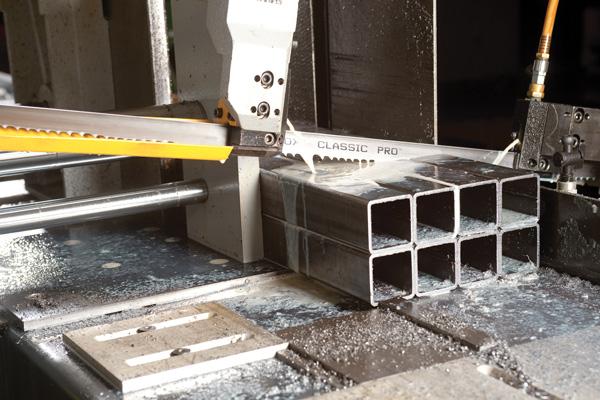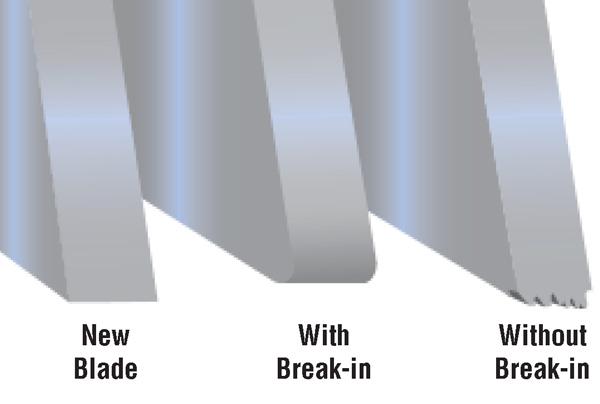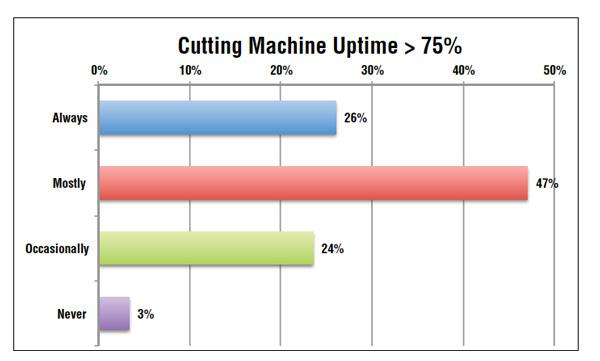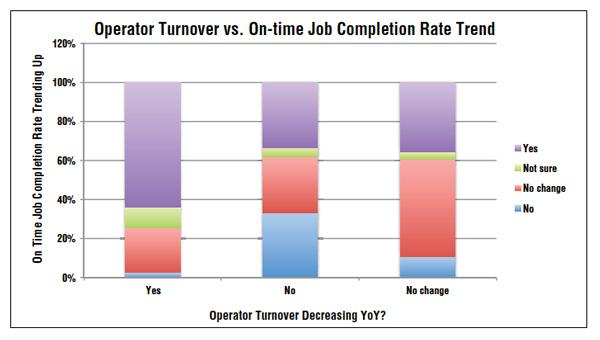- FMA
- The Fabricator
- FABTECH
- Canadian Metalworking
Measure, Slow Down, and Cut More
Focus on three areas of company operations to increase saw performance
- By Sue Roberts
- September 12, 2014
- Article
- Fabricating

Eleven percent of companies reported that they always bundle materials; 23 percent mostly; and 50 percent occasionally.
Metal cutting operations have three key areas where roadblocks stand in the way of increased shop floor productivity and efficiency, according to the “Benchmark Survey of Industrial Metal-Cutting Organizations,” conducted by the LENOX® Institute of Technology (LIT), East Longmeadow, Mass.
Actions to eliminate these barriers, at least in some cases, seem counterintuitive. Attention to internal process improvements, measuring and examining administrative and floor processes, and making changes that are not related to technology upgrades can be difficult, but can result in more parts out the door on time and at a larger profit margin.
Time typically dedicated to churning out parts needs to be invested in maintaining saws and blades to avoid unanticipated downtime. Operators need to pull time away from stacking up parts at the saw to expand their knowledge base.
Matt Lacroix, director of marketing at LENOX Industrial Products & Services, Newell Rubbermaid, discussed specific steps that metal cutting operations can take:
- Measure continually for smarter, more predictive operations management.
- Proactively maintain saws and blades.
- Conduct ongoing operator training.
Predict Downtime
Lacroix separated predictive operations management into two categories. The first category includes systems that provide the information to help businesses adjust management approaches to meet future expectations. An example is ERP software. “There are more and more sophisticated systems that allow companies to plan their jobs better, execute what they need to do more efficiently, and get the job out the door faster,” said Lacroix.
The second category is operations at the machine level and includes setting and adhering to equipment maintenance schedules. That’s wherepredictable downtime comes into play. With 73 percent of the survey respondents reporting saw uptime greater than 75 percent, stopping production for scheduled maintenance has to prove that it pays back.
“Taking a proactive maintenance stance by shutting a machine down to check on wear parts, topping off fluids, and making sure the machine is running optimally helps a company get the most out of the machine and the blade, and it makes the life of the operators and maintenance crew easier. Predictive downtime is less disruptive to the production cycle,” said Lacroix. “Think of it like your car. If you buy it and run it into the ground, it is going to break down. But provide preventive maintenance— like regularly changing the oil, fluids, and brake pads—and it keeps running and doesn’t leave you stranded at the wrong time.”
A few hours of scheduled maintenance can prevent unanticipated downtime that can keep equipment out of commission for days while the problem is identified, parts are ordered, and repairs are made.
The LIT survey found that 67 percent of operations that follow scheduled and planned machine maintenance also reported year-over-year improvements in job completion rates. About 50 percent of those companies said they could usually predict blade failure and make replacements before the part quality was affected or the blade broke to eliminate another source of lost production.
Companies implementing predictive maintenance were both large and small. The difference in their programs, Lacroix said, is how the maintenance is achieved. “The larger companies with several operations—band and circular sawing, drilling, and turning—frequently have their own maintenance staff. In the smaller companies, there is more of a reliance on their suppliers to provide maintenance as a value-added service.”

Seventy percent of organizations that reported their scrap was less than 5 percent always break in their blades. Slowing production for break-in leads to longer blade life, better cut quality, and lower tooling costs.
Make Time for Maintenance
Scheduled maintenance for equipment and blades needs to be viewed in the context of operational impact. Time used to monitor and tweak machine and blade performance can have a substantial impact on production efficiency and ontime delivery, particularly in high-production shops.
“There is definitely a tie between the performance of the machine and the performance of the blade,” said Lacroix. “The two major enemies of a blade are heat and vibration. Saw vibration can increase as certain parts start to wear. That vibration can transfer to the blade and negatively impact its performance and life. It will drive up scrap and tool costs.”
Slowing production to break in a new blade will add to both productivity and blade life. Seventy percent of the LIT survey respondents who said scrap and rework costs are less than 5 percent also said that they always break in their band saw blades.
Lacroix likened breaking in a new blade to using a newly sharpened pencil. “If you apply a lot of pressure when you write with a very sharp pencil, you are going to snap the tip off. If you start slowly and eventually form a rounded tip, the radius will allow you to apply more pressure and write for a longer time.
“The same is true about band saw blades. If you don’t break them in, you can chip the edges of the teeth or even fracture them. Ultimately, you’ll diminish blade life and, depending on the level of chipping, you can get poor finish on the parts.”
Invest in People
The survey found that organizations that invest in training and employee retention achieve levels of operational efficiency that may be overlooked by companies investing solely in technology. Fifty-one percent of companies investing in human capital reported reductions in operator turnover. As operator turnover decreased, 64 percent of the companies saw an increase in job completion rates.
“One study showed that CEOs in metalworking companies are disproportionately not investing in people. Investment in training has a lower priority than spending on technology,” Lacroix said. “But we found that there are very positive correlations between ongoing training, which can lead to employee retention, and operational performance, which leads to improved on-time customer delivery.”
Ongoing training provides a beginning knowledge base for new operators and keeps experienced operators current with newer technologies and automation. Many suppliers offer on-site training or e-learning modules that can be accessed as schedules allow. Regardless of the education delivery method, most employees view the opportunity to continue learning as an investment in them, which positively affects their output.
“If a company is not training its operators, and they are just punching a clock and pushing buttons, they won’t feel invested in the company. This impacts their productivity and the quality of their work. The study showed a strong correlation between happy people who are being developed, well-paid, and well-trained and a company with a low turnover rate and on-time deliveries,” said Lacroix.
Measure, Measure, Measure
The beginning point for breaking down barriers to increased productivity starts, in every case, with determining KPIs, key performance indicators, and continually measuring data.

Twenty-six percent of metal cutting operations said that their uptime is always more than 75 percent. Sixty-seven percent of companies that perform scheduled maintenance on their machines reported that their job completion rate is trending upward year-over-year.
“The more you can track, the better off you will be. You’ll know what kind of blade life you are getting, what your tooling costs are, your discard rates, and throughput. If you’re pretty steady on the amount you spend on tooling in a month and you get a big spike without producing more parts, it can be an indication of an issue with a machine or the blades,” said Lacroix.
“Measure operations and measure at the machine level to get the full picture so you can predict what needs to be done to improve.”
How Does Your Shop Compare?
Principals from over 100 metal cutting operations responded to the “Benchmark Survey of Industrial Metal-Cutting Organizations” conducted by LENOX Institute of Technology.
Here are some of the findings:
- 39 percent always meet customer demand.
- 11 percent always bundle materials.
- 26 percent said setup time is trending downward.
- 10 percent reported a downward trend in cycle times.
- 79 percent occasionally rework finished product because it did not pass first inspection.
- 47 percent reported no change in their metal cutting operator turnover.
See the full survey results at lenoxtools.mkt2106.comLenoxPR.
subscribe now


Keep up to date with the latest news, events, and technology for all things metal from our pair of monthly magazines written specifically for Canadian manufacturers!
Start Your Free Subscription- Trending Articles
- Industry Events
MME Winnipeg
- April 30, 2024
- Winnipeg, ON Canada
CTMA Economic Uncertainty: Helping You Navigate Windsor Seminar
- April 30, 2024
- Windsor, ON Canada
CTMA Economic Uncertainty: Helping You Navigate Kitchener Seminar
- May 2, 2024
- Kitchener, ON Canada
Automate 2024
- May 6 - 9, 2024
- Chicago, IL
ANCA Open House
- May 7 - 8, 2024
- Wixom, MI















